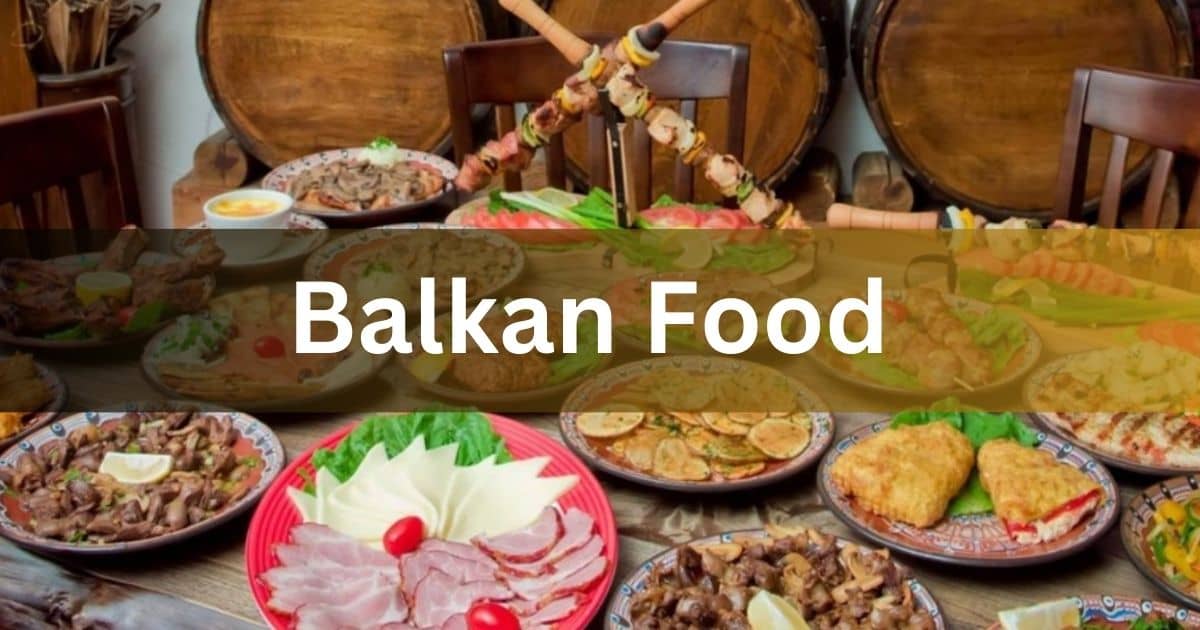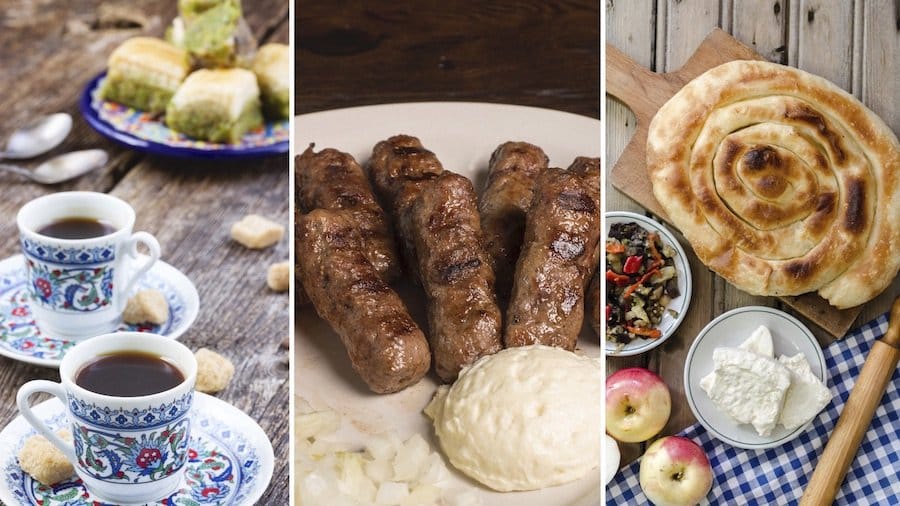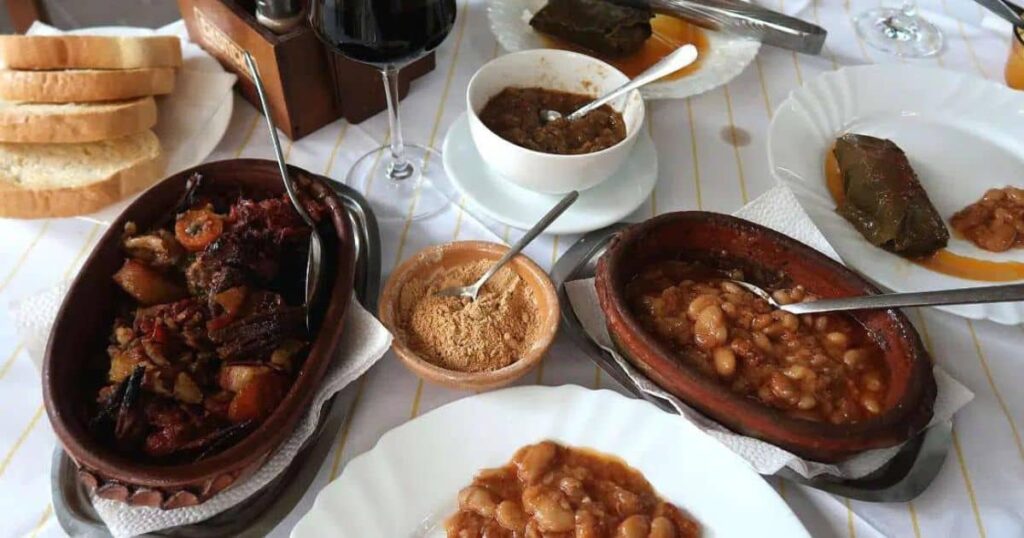Balkan Food – Complete Guide 2023!

Balkan food is diverse, with influences from Mediterranean and Eastern European cuisines. Common elements include grilled meats, burek (pastry filled with meat or cheese), ajvar (pepper-based condiment), and yogurt.
if you want to get more information about this topic let’s start your informational journey with us!
Table of Contents:
Describe the Balkans – Briefly Discuss!
The Balkans, also known as the Balkan Peninsula, is a region in Southeast Europe characterized by a rich and complex history, diverse cultures, and a tapestry of landscapes.
Encompassing countries such as Albania, Bosnia and Herzegovina, Bulgaria, Croatia, Greece, Kosovo, Montenegro, North Macedonia, Romania, Serbia, and Slovenia, the region is situated at the crossroads of Europe and Asia.

The historical narrative of the Balkans is intricate, shaped by a series of empires, conflicts, and cultural exchanges. The Byzantine Empire, Ottoman Empire, and Austro-Hungarian Empire have all left their imprint on the region, contributing to its cultural mosaic.
This historical layering is evident in the architecture, traditions, and religious influences found throughout the Balkans.
The diverse geography of the Balkans includes mountain ranges like the Dinaric Alps and the Balkan Mountains, as well as coastal areas along the Adriatic and Aegean Seas. The Danube River, one of Europe’s major waterways, also flows through parts of the region.
This varied topography influences both the climate and the types of crops that can be cultivated, influencing the local cuisine.
Culturally, the Balkans are a melting pot of different ethnicities, languages, and religions. This diversity is reflected in the multitude of festivals, music, dance, and art forms that are unique to each subregion and country.
The complex history has also led to occasional tensions and conflicts, but it has also fostered resilience and a sense of identity among the people of the Balkans.
Read Also: 9293572746 – UNRAVELING THE ROBOCALL MYSTERY!
Just what is food in Balkan? – Discuss with us!

Balkan cuisine is a reflection of the region’s diverse cultural influences, blending elements from Mediterranean and Eastern European traditions. The culinary landscape is characterized by hearty dishes, rich flavors, and a focus on fresh, locally sourced ingredients.
1. Grilled Meats:
A hallmark of Balkan cuisine is the love for grilled meats. Popular dishes include cevapi (small grilled sausages), Pljeskavica (ground meat patties), and Raznjici (skewered and grilled meats). Grilling is not just a cooking method but a cultural tradition, bringing people together over shared meals.
2. Burek and Pastries:
Burek, a flaky pastry filled with meat, cheese, or vegetables, is a staple in Balkan cuisine. Variations of this dish can be found across the region, showcasing the influence of Ottoman cuisine. Pastries, in general, play a significant role, with diverse fillings and shapes.
3. Ajvar and Relishes:
Ajvar, a roasted red pepper and eggplant relish, is a popular condiment in Balkan cuisine. It adds a flavorful and slightly smoky element to many dishes. Pickled vegetables and relishes are commonly served as side dishes, providing a balance to the richness of meats.
4. Dairy and Yogurt:
Dairy products hold a special place in Balkan cuisine. Yogurt is a common accompaniment to many meals, offering a refreshing contrast to the savory and grilled dishes. Kajmak, a creamy dairy spread, is another beloved component often enjoyed with bread or meat.
5. Seafood and Coastal Influences:
Coastal areas along the Adriatic and Aegean Seas bring a seafood element to Balkan cuisine. Grilled fish, octopus salads, and seafood stews showcase the influence of Mediterranean flavors in the coastal regions.
6. Stuffed Vegetables:
Stuffed vegetables, such as peppers, tomatoes, and grape leaves, are prevalent in Balkan cuisine. The fillings often include a mixture of rice, ground meat, and spices. This dish reflects both Ottoman and Mediterranean culinary traditions.
7. Influences from Ottoman and Austro-Hungarian Empires:
The historical influences of the Ottoman and Austro-Hungarian Empires are evident in Balkan cuisine. From Turkish delights to schnitzels, the culinary heritage is a testament to the region’s complex history.
Read Also: WAYNE LIANG – ULTIMATE GUIDE FOR YOU!
Classic Balkan Recipes You Must Taste – Let’s Explore!
Balkan cuisine boasts a treasure trove of classic recipes that reflect the region’s rich culinary heritage. From savory grilled meats to delectable pastries, here are 28 must-try dishes that capture the essence of Balkan flavors.

- Cevapi: These small, grilled sausages made from minced meat (usually a mix of beef and pork) are a beloved Balkan dish, often served with flatbread and a side of ajvar.
- Burek: A flaky pastry filled with layers of minced meat, cheese, or vegetables, burek is a staple in Balkan cuisine, enjoyed both as a snack and a main dish.
- Pljeskavica: These grilled ground meat patties, often made with a mix of beef and pork, are a popular choice, served on a flatbread with toppings like kajmak and ajvar.
- Ajvar: A roasted red pepper and eggplant relish, ajvar adds a burst of flavor to many Balkan dishes, serving as a versatile condiment.
- Sarma: Stuffed cabbage rolls, known as sarma, feature a filling of minced meat and rice, wrapped in pickled cabbage leaves and slow-cooked for a deliciously comforting dish.
- Shopska Salad: A refreshing salad made with tomatoes, cucumbers, peppers, onions, and feta cheese, drizzled with olive oil, showcasing the vibrant produce of the region.
- Kebabs: Marinated and grilled skewers of meat, often served with a side of rice or bread, reflect the influence of Ottoman cuisine in the Balkans.
- Goulash: A hearty stew of meat (commonly beef), potatoes, and vegetables, goulash highlights the Austro-Hungarian influence in Balkan cooking.
- Moussaka: Layered casserole with eggplant, minced meat, and béchamel sauce, moussaka is a comforting dish with variations found throughout the Balkans.
- Pita: Not to be confused with Middle Eastern bread, Balkan pita is a phyllo pastry filled with cheese, potatoes, or pumpkin, creating a delightful savory treat.
- Japrak: Stuffed grape leaves, or Japrak, feature a filling of rice and minced meat, providing a burst of flavor in a bite-sized package.
- Riblja Corba: A spicy fish soup, Riblja Corba, is a popular dish along the Adriatic coast, showcasing the Balkan love for seafood.
- Kajmak: A creamy dairy spread often enjoyed with bread or meat, kajmak is a quintessential element of Balkan breakfasts and appetizers.
- Karadjordjeva Schnitzel: This breaded and stuffed veal or pork schnitzel is named after a Serbian royal figure and is a favorite comfort food in the region.
- Tavche Gravche: A Macedonian dish of baked beans, Tavche Gravche is seasoned with paprika and often served with a side of bread.
- Pasulj: A hearty bean soup, Pasulj is a traditional Balkan dish enjoyed in various forms, with regional variations in ingredients and seasonings.
Read Also: ABSOLUTE HYPNOSIS IN ANOTHER WORLD CHAPTER 74 – A JOURNEY INTO THE UNKNOWN!
Frequently Asked Questions:
1. What is ajvar, and how is it used in Balkan dishes?
Ajvar is a roasted red pepper and eggplant relish. It serves as a versatile condiment, enhancing the flavor of grilled meats, sandwiches, or as a dip. It adds a smoky and rich taste to various Balkan dishes.
2. Are there vegetarian options in Balkan cuisine?
Yes, Balkan cuisine offers vegetarian options. Dishes like stuffed peppers (Paprika Punjene) or spinach and cheese pies (pita Zeljanica) cater to vegetarian preferences. Additionally, salads, bean soups, and various vegetable-based stews are popular.
3. How is Balkan cuisine influenced by its history?
Balkan cuisine reflects the region’s history through Ottoman and Austro-Hungarian influences. The use of spices, phyllo pastry, and dishes like goulash showcase this historical blend. Coastal regions also incorporate Mediterranean flavors due to geographical proximity.
Conclusion:
At the end of the conclusion;
Balkan cuisine exhibits diversity, drawing inspiration from both Mediterranean and Eastern European culinary traditions. It features a variety of elements such as grilled meats, burek, ajvar, and yogurt.
I hope you will all understand the concepts of Balkan Food.




